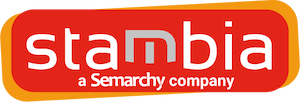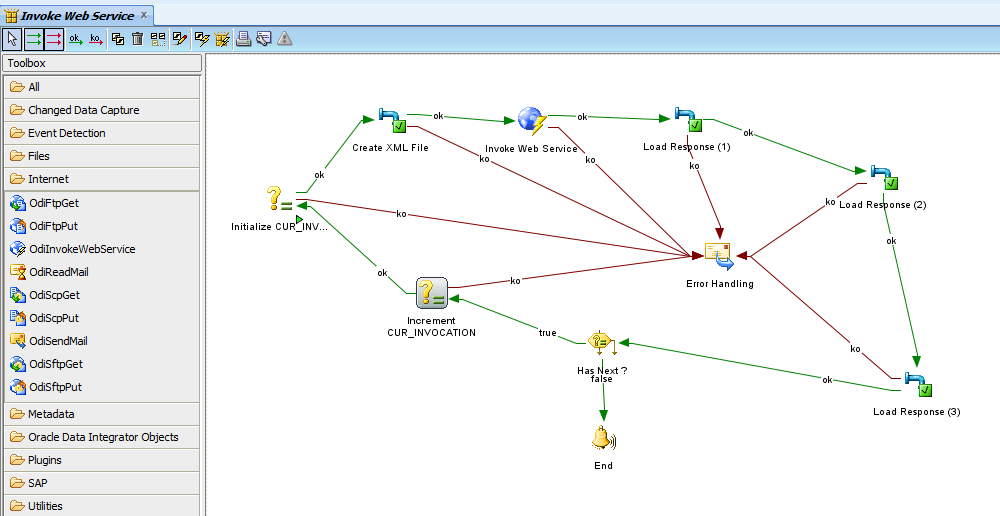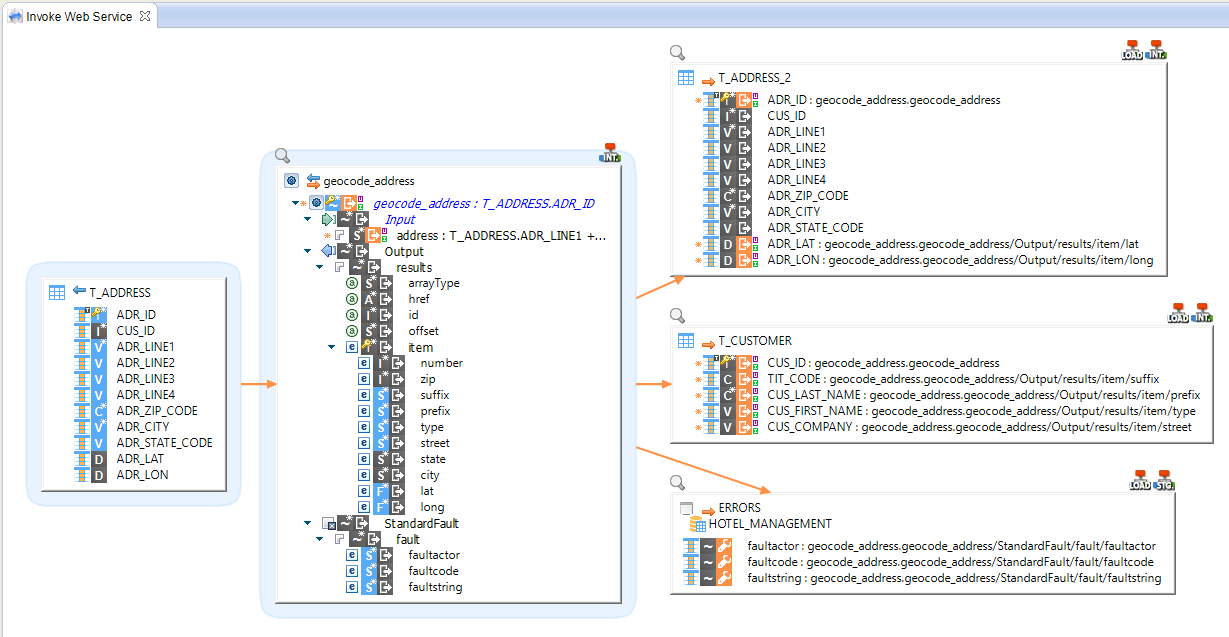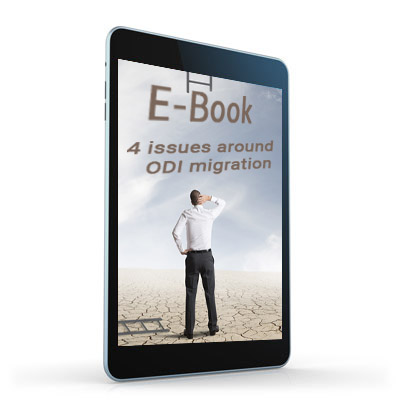 Stambia
The solution to all your data integrations needs
Stambia
The solution to all your data integrations needs

An ELT alternative to Oracle Data Integrator (ODI) ?
Companies often have difficulties accelerating their digital transformations using traditional data integration solutions. These solutions tend to get more complex and less adaptable for new technologies. To meet new challenges, companies now need to be agile when handling projects with various types of new technologies. They also need to speed up the "time to market", another key factor of success for these data integration projects.
Thanks to its unified solution and scalable technology, Stambia allows you to accelerate and industrialize your digital transformation while modernizing your information system, just in a few clicks!

Your questions about Oracle Data Integrator?
How to deal with Big Data, NoSQL, Web services / API projects?
A traditional data integration platform such as Oracle Data Integrator (formerly Sunopsis) is designed (and is very suitable) to process data in tabular form (tables, flat files) with very good performance levels.
However, when dealing with hierarchical structures such as XML, JSON, productivity or performance difficulties can arise. Indeed, the tabular oriented vision means that it may be necessary, for each hierarchical level, to develop an interface (a mapping), then to group these interfaces into a package.
The phenomenon can also increase, when business teams launch e-commerce, CRM, PIM initiatives... these projects requiring the usage of Web services, unstructured data and/or NoSQL databases.
Therefore it may be difficult to handle a Big Data initiative.

Do you need to simplify your data integration solution?

Traditional data integration solutions may tend to complicate their architecture or the way to develop as soon as new third-party technologies appear on the market.
You may encounter challenges with your current solution:
- The need to install an Oracle Weblogic application server?
- A multiplication of technological solutions necessary to cover the entire spectrum of Data Integration: ETL, ESB, CDC, WebLogic, Fusion Middleware?
- A usage of third-party components to complete the basic features (Golden Gate)?
- Complex mappings and packages?
Would you like to reduce your ownership costs?
The data integration solution is at the heart of the company's data exchanges. Data processing is disrupted by new technologies and methods. It is now possible to process more and more data, and a wide variety of them. Along with these evolutions, it is necessary to ensure the digital transformation of the company.
It is therefore essential to have a solution with a flexible and readable pricing model, in line with these new challenges.
Your bill increases from year to year, but you don't have any real services in addition?
Stambia offers Linear Ownership Costs: a pricing system based on the number of designers, which smooths out the cost of ownership over time.
Having trouble reading the cost of your current solution?
Stambia offers Readable Ownership Costs: 3 simple offers, each based on the development effort.
The rise of the Cloud and the multiplication of manipulated technologies increases your cost of ownership?
Stambia offers ownership costs Adapted to today's world: Stambia's model, which is not based on the transformation power, or the number of source and target components, makes it possible to remove all obstacles to the development of new projects.

Do you have any challenges to migrate to the latest ODI version ?

You may have problems migrating to new versions of your current ODI solution. The new version brings structural changes because it wants to integrate as well as possible into its ecosystem (software from the same publisher). All this may be at the expense of your independence and productivity.
Automatic upgrades are no longer possible? Is it necessary to set up a complex process, which requires full technical and functional tests?
Perhaps you are asking yourself: should we migrate to the latest version? Should we choose another solution and redevelop everything? Or more simply, can we find an alternative solution that is close to the current solution and that allows us to migrate in a (almost) transparent way?
Switch to agile data integration
Migrate seamlessly: simple and straightforward recovery
Why choose Stambia Data Integration?
- Keep the same development philosophy through Stambia mapping
- Keep the same ELT transformation principles, such as in Sunopsis or Oracle Data Integrator
- Benefit from a Stambia toolbox to facilitate the migration of the developments done in Sunopsis / Oracle Data Integrator (ODI)
- Reliable methodology proven by Stambia and its customers
The migration from Oracle Data Integrator (ODI) to Stambia can be done with no Big Bang effect, in a mastered and progressive way, with a real control on the costs.
Rely on Data Integration specialists: Stambia's team consists of data management experts who have supported many customers in their migration from Sunopsis / Oracle Data Integrator (ODI) to Stambia.
Accelerate digital transformation

Nowadays, data is at the origin and at the heart of the company's activity. In the context of digital transformation, a data integration solution must be agile and flexible to support and accelerate projects and business challenges.
Stambia offers a unified solution that covers all data integration needs. Stambia technology makes it possible to address current and future technological challenges.
Stambia benefits:
- An API studio to facilitate the development of APIs and the "API-zation" of the Legacy information system as part of an IS modernization initiative (API my Legacy)
- A unified solution to simplify Big Data initiatives
- An agile solution for the management of unstructured NoSQL databases often associated with e-commerce, PIM and other web projects
- A complete environment to lead a 360° customer initiative with the implementation of a CRM such as Salesforce
Data Integration : productivity and performance gains
The data integration solution is at the heart of the information system exchanges. A new solution must provide real and tangible benefits in terms of productivity and performance.
A few examples of the benefits provided by Stambia Data Integration solutions:
- Development productivity:
- x10 gains on technologies such as JSON, XML
- Gains x5 to x20 for Web services / API development
- Industrialization:
- 80% of our customers go live with their first data integration project in less than 3 weeks
- Performance:
- Native ability to manage parallelization
- Thanks to the ELT mode and thanks to the templates which are specific to each technology, Stambia optimizes the usage of each third-party technology.
- Lightweight execution engines, easy to install and duplicate
« 5 days were enough for the solution to be operational in our context. Thanks to the technical templates, everything is prepared, the tool is simple and intuitive, and ready to use » Virginie Samson - ProBTP
User proximity and customer relationship

Among the criteria for choosing a data integration solution, there is an important point: select a software publisher with whom it is possible to establish a real and trustable relationships. To guarantee the fast delievry of the projects (reduce time to market), it is necessary to have visibility and commitments from the software provider.
Also, choosing Stambia means:
- A software provider that listens to its customers and users
- A reactive support team with a commitment to find solutions for each customer/user request
« (...) Stambia is a facilitator, we develop our connectors with their assistance and support, they are very close to us and we feel truly accompanied. I think I could rate it 5/5 if I had to rate Norauto's level of satisfaction » Maryse Mechain - Norauto
Technical specifications and prerequisites
| Specifications | Description |
|---|---|
|
Oracle Data Integrator (ODI) / Sunopsis version |
|
|
Environnement matériel et logiciel pour la migration |
|
| Terminology |
Oracle Data Integrator (ODI)
Stambia
|
| Connectivity |
For more information, consult the technical documentation |
|
Standard features |
|
|
Advanced features |
|
| Stambia Version | From Stambia Designer s19.0.0 |
| Stambia Runtime version | From Stambia Runtime S17.4.8 |
| Notes |
|
Do you want to know more ?
Consult our resources
Did not find what you want on this page?
Check out our other resources:

Discover our migration framework : from Oracle ODI to Stambia
Semarchy has acquired Stambia
Stambia becomes Semarchy xDI Data Integration





